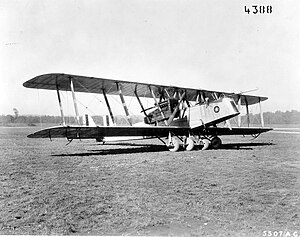Martin MB-1
| Martin MB-1 | |
|---|---|
 US Army MB-1 |
|
| Type: | bomber |
| Design country: | |
| Manufacturer: | |
| First flight: |
August 15 and 17, 1918 |
| Commissioning: |
1918 |
| Production time: |
1918 to 1919 |
| Number of pieces: |
22nd |
The Martin MB-1 , also known as the Glenn Martin Bomber (GMB) , is the first US- developed bomber that the US armed forces procured in large numbers. The Glenn L. Martin Company developed it in 1918 and it remained in service until 1931.
Development history
Mission and development
After the US entered World War I in April 1917 , the army demanded powerful aircraft. In January 1918, Martin received the order to develop a bomber and thus entered into competition with designs from the European manufacturers Caproni and Handley Page .
For the new project, Martin built a new factory building in Cleveland , Ohio, with a floor space of over 5600 m². Donald Wills Douglas , who years later was to found his own aircraft company, developed the MB-1 : a biplane with a wooden frame fuselage and fabric covering, two 400 hp Liberty engines, a wingspan of 21.8 meters and a takeoff weight of over 4,500 Kilogram. Five machine guns with a caliber of 7.62 mm served as armament .
production
After the first flight on August 15th (according to another source 17th) August 1918, the US Army tested the MB-1 against the European competing models. The Martin bomber proved to be faster and more agile and so the army ordered fifty machines for their anticipated missions against Germany. The imminent end of the war in November 1918 reduced the order to ten, which were delivered between September 1918 and September 1919.
variants
At the end of the war, the Army Air Service , the new air force division of the US Army, no longer had any real use for the new bombers. Therefore, Martin equipped the first four machines as observation aircraft, with machine guns, cameras and a bomb load of up to 100 kg, called Model G for Gunner .
The next three units were built as night bombers (Model M ), but met with so little interest from the military that one machine was sent straight from the factory to the Smithsonian Museum .
The last three MB-1 each received special equipment. The model TA (for Trans Atlantic , army designation GMT ) had tanks for an additional 2460 liters of fuel for overseas flights, but was destroyed in a storm in July 1919. The CA (for Cannon , also GMC ) served tests with a 37-mm cannon on board and the 12P (GMP) was designed for the transport of twelve passengers. When switching to a new naming system in 1919, it was given the designation T-1 - the first official transport aircraft of the US Air Force .
This was followed by the civil variant MP for mail flights on the New York - Chicago route with a payload of up to 680 kg, which was built six times, but of which only two machines were intact after a few months in early 1920 and finally went to the army.
When the US Navy ordered a torpedo bomber, Martin produced two MBTs that could carry a 750 kg torpedo in early 1920 , and another eight MTs by the end of the year .
Martin built a total of ten MB-1s and a further 16 of the variants based on them. The fifth MB-1 later received a third engine from Hispano-Suiza on a trial basis . In 1931 the last MB-1 were taken out of service.
Improved model
The actual breakthrough came with the MB type with the revised successor model Martin MB-2 , which Martin produced from 1920.
Technical specifications
| Parameter | Data of the Martin MB-1 |
|---|---|
| length | 13.7 m |
| span | 21.8 m |
| height | 4.5 m |
| Empty weight | 3.04 t |
| Maximum takeoff weight | 4.64 t |
| Maximum bomb load | 470 kg |
| Top speed | 170 km / h |
| Maximum altitude | 3750 m |
| Range with max. Payload | 630 km |
| drive | Two Liberty L-12 A (V 1650; V12 engine with water cooling) with around 294 kW / 400 PS each |
| crew | Three (pilot, bombardier, machine gunner) |
Web links